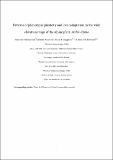Files in this item
Patterns of phenotypic plasticity and local adaptation in the wide elevation range of the alpine plant Arabis alpina
Item metadata
| dc.contributor.author | de Villemereuil, Pierre | |
| dc.contributor.author | Mouterde, Médéric | |
| dc.contributor.author | Gaggiotti, Oscar E. | |
| dc.contributor.author | Till-Buttraud, Irène | |
| dc.date.accessioned | 2019-03-25T00:37:53Z | |
| dc.date.available | 2019-03-25T00:37:53Z | |
| dc.date.issued | 2018-09 | |
| dc.identifier | 252215713 | |
| dc.identifier | 768ae991-4fd1-4ea5-994d-e34989bd4dbd | |
| dc.identifier | 85044262656 | |
| dc.identifier | 000452178600016 | |
| dc.identifier.citation | de Villemereuil , P , Mouterde , M , Gaggiotti , O E & Till-Buttraud , I 2018 , ' Patterns of phenotypic plasticity and local adaptation in the wide elevation range of the alpine plant Arabis alpina ' , Journal of Ecology , vol. 106 , no. 5 , pp. 1952–1971 . https://doi.org/10.1111/1365-2745.12955 | en |
| dc.identifier.issn | 0022-0477 | |
| dc.identifier.other | ORCID: /0000-0003-1827-1493/work/61370125 | |
| dc.identifier.uri | https://hdl.handle.net/10023/17359 | |
| dc.description | OEG was supported by the Marine Alliance for Science and Technology for Scotland (MASTS). | en |
| dc.description.abstract | 1. Local adaptation and phenotypic plasticity are two important characteristics of alpine plants to overcome the threats caused by global changes. Among alpine species, Arabis alpina is characterised by an unusually wide altitudinal amplitude, ranging from 800 to 3,100 m of elevation in the French Alps. Two non‐exclusive hypotheses can explain the presence of A. alpina across this broad ecological gradient: adaptive phenotypic plasticity or local adaptation, making this species especially useful to better understand these phenomena in alpine plant species. 2. We carried out common garden experiments at two different elevations with maternal progenies from six sites that differed in altitude. We showed that (1) key phenotypic traits (morphotype, total fruit length, growth, height) display significant signs of local adaptation, (2) most traits studied are characterised by a high phenotypic plasticity between the two experimental gardens and (3) the two populations from the highest elevations lacked morphological plasticity compared to the other populations. 3. By combining two genome scan approaches (detection of selection and association methods), we isolated a candidate gene (Sucrose‐Phosphate Synthase 1). This gene was associated with height and local average temperature in our studied populations, consistent with previous studies on this gene in Arabidopsis thaliana. 4. Synthesis. Given the nature of the traits involved in the detected pattern of local adaptation and the relative lack of plasticity of the two most extreme populations, our findings are consistent with a scenario of a locally adaptive stress response syndrome in high elevation populations. Due to a reduced phenotypic plasticity, an overall low intra‐population genetic diversity of the adaptive traits and weak gene flow, populations of high altitude might have difficulties to cope with, e.g. a rise of temperature. | |
| dc.format.extent | 20 | |
| dc.format.extent | 257357 | |
| dc.language.iso | eng | |
| dc.relation.ispartof | Journal of Ecology | en |
| dc.subject | Local adaptation | en |
| dc.subject | Phenotypic plasticity | en |
| dc.subject | Common garden | en |
| dc.subject | RAD sequencing | en |
| dc.subject | Arabis alpina | en |
| dc.subject | Alpine ecology | en |
| dc.subject | QH301 Biology | en |
| dc.subject | QH426 Genetics | en |
| dc.subject | SB Plant culture | en |
| dc.subject | DAS | en |
| dc.subject.lcc | QH301 | en |
| dc.subject.lcc | QH426 | en |
| dc.subject.lcc | SB | en |
| dc.title | Patterns of phenotypic plasticity and local adaptation in the wide elevation range of the alpine plant Arabis alpina | en |
| dc.type | Journal article | en |
| dc.contributor.institution | University of St Andrews. School of Biology | en |
| dc.contributor.institution | University of St Andrews. Marine Alliance for Science & Technology Scotland | en |
| dc.contributor.institution | University of St Andrews. Scottish Oceans Institute | en |
| dc.identifier.doi | 10.1111/1365-2745.12955 | |
| dc.description.status | Peer reviewed | en |
| dc.date.embargoedUntil | 2019-03-25 |
This item appears in the following Collection(s)
Items in the St Andrews Research Repository are protected by copyright, with all rights reserved, unless otherwise indicated.

